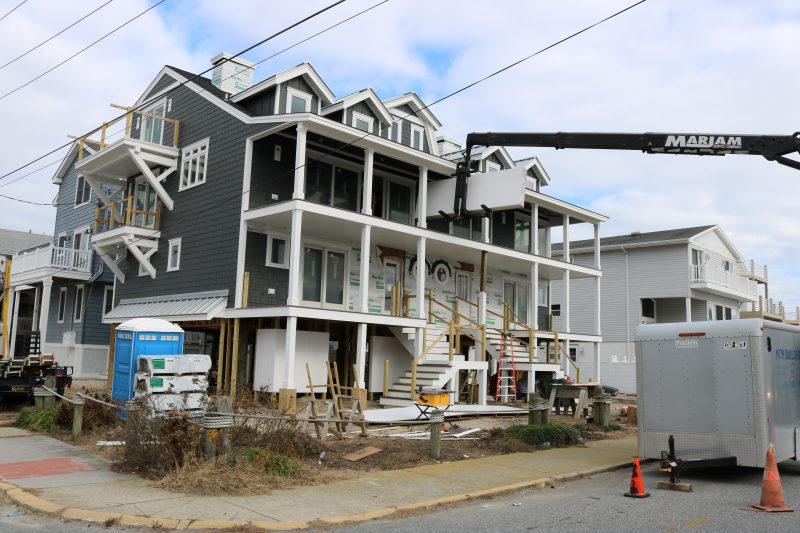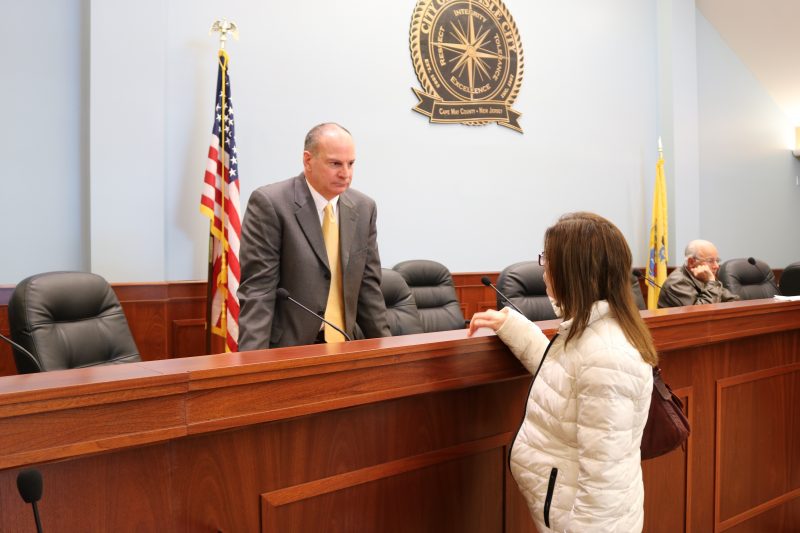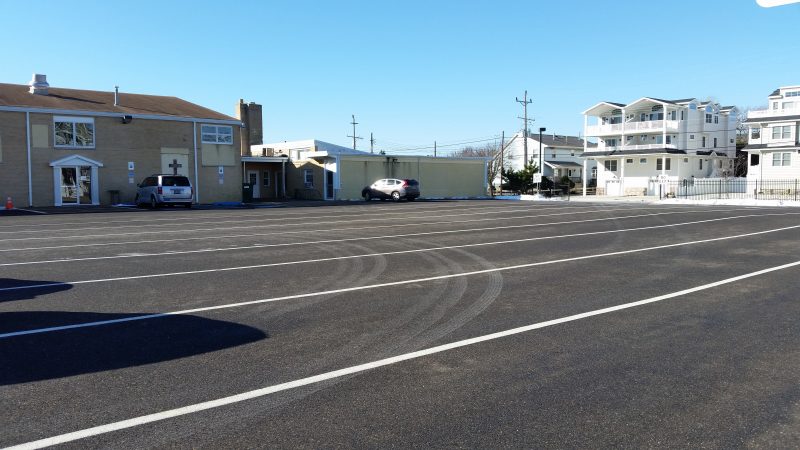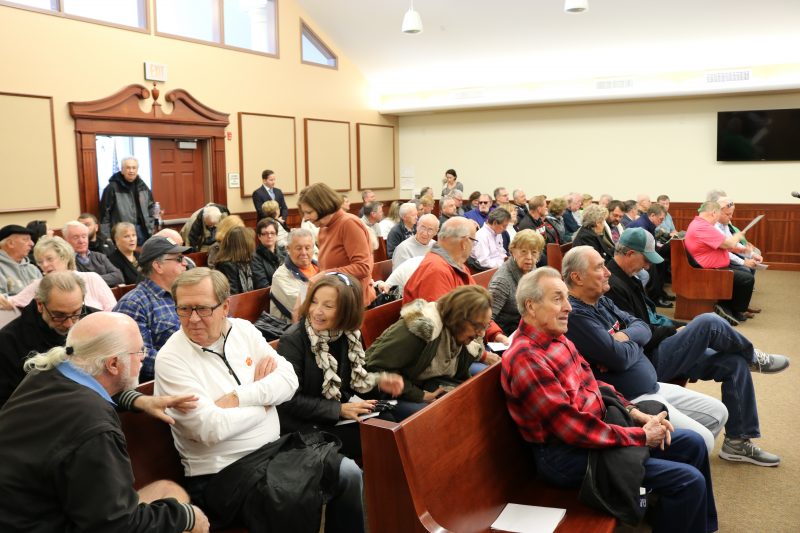Luxury homes like this one under construction at 61st Street and Pleasure are emblematic of Sea Isle's upscale real estate market, but the town is required to provide its "fair share" of affordable housing.
 By Donald Wittkowski
As a packed audience looked on, City Council gave final approval Tuesday to Sea Isle City’s affordable housing plan.
Zoning changes contained in three new ordinances adopted by the governing body will allow the upscale beach town to fulfill its state constitutional mandate to provide its “fair share” of affordable housing, Sea Isle’s attorney said.
“We try to make it fair to the neighborhood and fair to the developer,” City Solicitor Paul Baldini told dozens of residents who jammed the Council Chambers to hear details about the housing plan.
During a 90-minute public hearing that preceded the Council vote, residents largely expressed concerns about the possibility that their property values might decline if affordable housing is built next to their homes.
“How does this affect property values?” Betty Graham, a resident of 43rd Place since 1989, pointedly asked Baldini.
Baldini responded that Sea Isle’s property values have continued to rise in recent years, even though it was well known the city has been working with the courts on a final plan for affordable housing.
“I believe property values will not be affected at all by this,” he said.
By Donald Wittkowski
As a packed audience looked on, City Council gave final approval Tuesday to Sea Isle City’s affordable housing plan.
Zoning changes contained in three new ordinances adopted by the governing body will allow the upscale beach town to fulfill its state constitutional mandate to provide its “fair share” of affordable housing, Sea Isle’s attorney said.
“We try to make it fair to the neighborhood and fair to the developer,” City Solicitor Paul Baldini told dozens of residents who jammed the Council Chambers to hear details about the housing plan.
During a 90-minute public hearing that preceded the Council vote, residents largely expressed concerns about the possibility that their property values might decline if affordable housing is built next to their homes.
“How does this affect property values?” Betty Graham, a resident of 43rd Place since 1989, pointedly asked Baldini.
Baldini responded that Sea Isle’s property values have continued to rise in recent years, even though it was well known the city has been working with the courts on a final plan for affordable housing.
“I believe property values will not be affected at all by this,” he said.
 Sea Isle resident Betty Graham, of 43rd Place, questions city officials about the affordable housing plan's possible impact on property values.
Teri Gallo, who lives on 45th Street and was one of the residents who spoke during Council’s public hearing, said city officials relieved most of the concerns she had about the affordable housing plan, including the possibility of more crime.
“It sounds like the town council was really thorough in the way they approached this and is really looking after the best interests of the residents,” Gallo said in an interview after the meeting.
Sea Isle has an “immediate need” for just two affordable housing units, Baldini explained. The low number is the result of the scarcity of developable land in a town crowded with high-end vacation homes built on premium seashore property.
The plan calls for creating “overlay zones” where affordable housing units could be sprinkled throughout town instead of trying to cram large, multi-family projects in one concentrated area, city officials said.
Developers would be given tax and construction incentives to include affordable housing units in their projects. For instance, they would be allowed to build one extra unit of market-rate housing if they also include one unit of affordable housing in the same project, Baldini said.
Sea Isle resident Betty Graham, of 43rd Place, questions city officials about the affordable housing plan's possible impact on property values.
Teri Gallo, who lives on 45th Street and was one of the residents who spoke during Council’s public hearing, said city officials relieved most of the concerns she had about the affordable housing plan, including the possibility of more crime.
“It sounds like the town council was really thorough in the way they approached this and is really looking after the best interests of the residents,” Gallo said in an interview after the meeting.
Sea Isle has an “immediate need” for just two affordable housing units, Baldini explained. The low number is the result of the scarcity of developable land in a town crowded with high-end vacation homes built on premium seashore property.
The plan calls for creating “overlay zones” where affordable housing units could be sprinkled throughout town instead of trying to cram large, multi-family projects in one concentrated area, city officials said.
Developers would be given tax and construction incentives to include affordable housing units in their projects. For instance, they would be allowed to build one extra unit of market-rate housing if they also include one unit of affordable housing in the same project, Baldini said.
 City Solicitor Paul Baldini speaks to resident Teri Gallo, of 45th Street, about the affordable housing plan.
New Jersey law allows municipalities to satisfy 25 percent of their affordable housing obligations by building units for senior citizens.
Baldini said Sea Isle’s plan also creates new zones for affordable senior-citizen housing on what is currently a parking lot on Landis Avenue between 58th and 59th streets and another area now used for parking on Central Avenue between 44th and 45th streets.
The parking lot on Central Avenue is owned by the St. Joseph Catholic Church, while the one on Landis Avenue is owned by the Sisters of Mercy, another Catholic organization.
Church-owned land was designated as possible sites for affordable housing because of the history of churches in general to partner with charitable organizations and other groups that specialize in affordable housing, Baldini noted.
City Solicitor Paul Baldini speaks to resident Teri Gallo, of 45th Street, about the affordable housing plan.
New Jersey law allows municipalities to satisfy 25 percent of their affordable housing obligations by building units for senior citizens.
Baldini said Sea Isle’s plan also creates new zones for affordable senior-citizen housing on what is currently a parking lot on Landis Avenue between 58th and 59th streets and another area now used for parking on Central Avenue between 44th and 45th streets.
The parking lot on Central Avenue is owned by the St. Joseph Catholic Church, while the one on Landis Avenue is owned by the Sisters of Mercy, another Catholic organization.
Church-owned land was designated as possible sites for affordable housing because of the history of churches in general to partner with charitable organizations and other groups that specialize in affordable housing, Baldini noted.
 A parking lot on Central Avenue between 44th and 45th streets, owned by St. Joseph Catholic Church, is one area proposed for affordable housing for senior citizens.
Overall, Sea Isle’s plan includes a total of 372 units of affordable housing to be built through 2025. The units would be scattered throughout the city instead of being concentrated in just a few locations because of the scarcity of developable land on the barrier island.
In an interview after the Council meeting, Baldini stressed there is nowhere near the amount of developable land in town needed to build 372 units. Instead, the housing plan designates areas throughout town where much smaller amounts of affordable units might be built in coming years.
Adam Gordon, an attorney for the Fair Share Housing Center, which negotiated a court settlement with Sea Isle, acknowledged it would be unrealistic to think that 372 units would ever be developed, considering the lack of available land.
Gordon estimated earlier this year that perhaps 50 to 75 units could be added over time if the local churches ever decide to develop their land in partnership with organizations that specialize in affordable housing.
City Councilman Frank Edwardi assured the audience Tuesday that Sea Isle’s Zoning Board would carefully scrutinize any affordable housing projects if developers sought variances for construction.
“There’s no rubber stamp on this,” Edwardi said.
A parking lot on Central Avenue between 44th and 45th streets, owned by St. Joseph Catholic Church, is one area proposed for affordable housing for senior citizens.
Overall, Sea Isle’s plan includes a total of 372 units of affordable housing to be built through 2025. The units would be scattered throughout the city instead of being concentrated in just a few locations because of the scarcity of developable land on the barrier island.
In an interview after the Council meeting, Baldini stressed there is nowhere near the amount of developable land in town needed to build 372 units. Instead, the housing plan designates areas throughout town where much smaller amounts of affordable units might be built in coming years.
Adam Gordon, an attorney for the Fair Share Housing Center, which negotiated a court settlement with Sea Isle, acknowledged it would be unrealistic to think that 372 units would ever be developed, considering the lack of available land.
Gordon estimated earlier this year that perhaps 50 to 75 units could be added over time if the local churches ever decide to develop their land in partnership with organizations that specialize in affordable housing.
City Councilman Frank Edwardi assured the audience Tuesday that Sea Isle’s Zoning Board would carefully scrutinize any affordable housing projects if developers sought variances for construction.
“There’s no rubber stamp on this,” Edwardi said.
 Residents pack the Council Chambers to listen to details about the affordable housing plan.
Sea Isle, meanwhile, is following the same route as many other municipalities in New Jersey in fulfilling their affordable housing requirements, Baldini pointed out.
In 2015, the city sought a court order declaring that it was in compliance with the state’s Fair Housing Act of 1985 as well as the landmark Mount Laurel court doctrine requiring New Jersey municipalities to provide their “fair share” of affordable housing.
Bringing the litigation to a close, Sea Isle and the court-designated Fair Share Housing Center reached agreement last December on the city’s affordable housing needs. A state Superior Court judge approved the settlement.
By negotiating a court-approved settlement and creating areas where affordable housing can be built, the city will avoid exposing itself to developers’ lawsuits challenging Sea Isle’s zoning laws, Baldini said.
“We had to do what was right for the town. We believe this plan is defendable in court,” he said.
Sea Isle was facing a Nov. 30 deadline to adopt its affordable housing plan. After that date, if the plan had not been approved, the city would have lost its immunity from developers’ lawsuits, Baldini said.
Development fees will help finance the city’s affordable housing plan, according to the ordinances. Baldini told the residents that their taxes will not increase by “one dime” to fund affordable housing projects.
“Your taxes will not go up for affordable housing,” he said.
Baldini added that Mayor Leonard Desiderio was “adamant” about crafting an affordable housing plan that would not place a financial burden on taxpayers.
Sea Isle has evolved into a more upscale housing market in recent years, with the median home value now around $640,000 and multimillion-dollar oceanfront homes becoming commonplace.
But the new plan provides a “realistic opportunity for production of affordable housing with a minimal impact on neighborhood character and community services,” according to a city planning document.
Residents pack the Council Chambers to listen to details about the affordable housing plan.
Sea Isle, meanwhile, is following the same route as many other municipalities in New Jersey in fulfilling their affordable housing requirements, Baldini pointed out.
In 2015, the city sought a court order declaring that it was in compliance with the state’s Fair Housing Act of 1985 as well as the landmark Mount Laurel court doctrine requiring New Jersey municipalities to provide their “fair share” of affordable housing.
Bringing the litigation to a close, Sea Isle and the court-designated Fair Share Housing Center reached agreement last December on the city’s affordable housing needs. A state Superior Court judge approved the settlement.
By negotiating a court-approved settlement and creating areas where affordable housing can be built, the city will avoid exposing itself to developers’ lawsuits challenging Sea Isle’s zoning laws, Baldini said.
“We had to do what was right for the town. We believe this plan is defendable in court,” he said.
Sea Isle was facing a Nov. 30 deadline to adopt its affordable housing plan. After that date, if the plan had not been approved, the city would have lost its immunity from developers’ lawsuits, Baldini said.
Development fees will help finance the city’s affordable housing plan, according to the ordinances. Baldini told the residents that their taxes will not increase by “one dime” to fund affordable housing projects.
“Your taxes will not go up for affordable housing,” he said.
Baldini added that Mayor Leonard Desiderio was “adamant” about crafting an affordable housing plan that would not place a financial burden on taxpayers.
Sea Isle has evolved into a more upscale housing market in recent years, with the median home value now around $640,000 and multimillion-dollar oceanfront homes becoming commonplace.
But the new plan provides a “realistic opportunity for production of affordable housing with a minimal impact on neighborhood character and community services,” according to a city planning document.